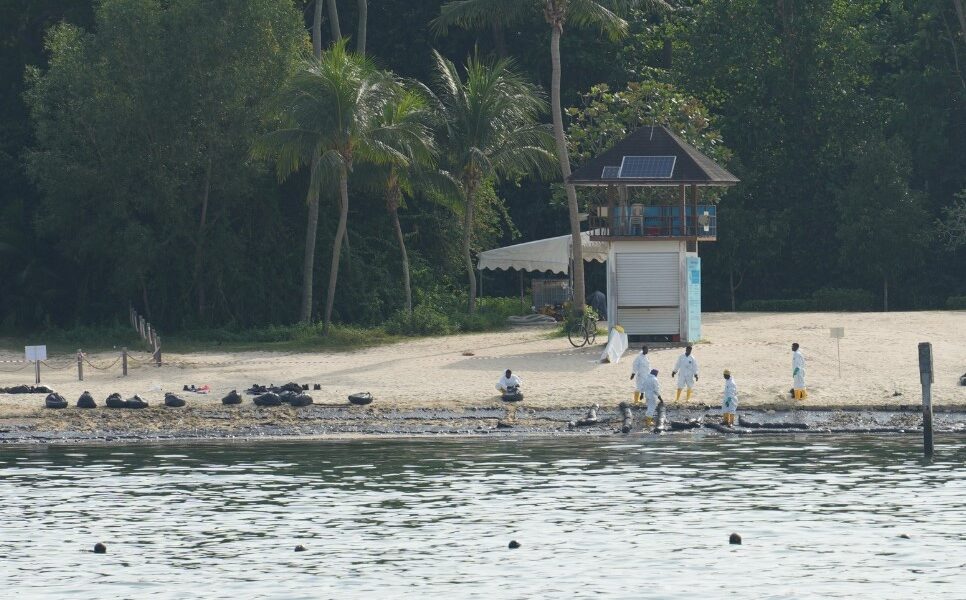SINGAPORE: Following an oil spill last week, efforts to clean up affected beaches in Singapore are progressing.
Transport Minister Chee Hong Tat stated on Thursday (20 June) that although significant strides have been made, complete removal of the oil will still “take some time.”
In a joint statement the same day, Singaporean authorities reported that the National Environment Agency (NEA) has made substantial headway at East Coast Park, clearing a “large majority” of oil deposits from the beach.
Similarly, significant cleanup progress has been achieved at Tanah Merah beaches. Additionally, beaches on St John’s, Lazarus, and Kusu islands, along with most of Siloso beach on Sentosa, have been cleared of oily sand.
Mr Chee highlighted progress in a Facebook post, emphasizing the ongoing focus on removing visible oil slicks and sheens from water and land using drone surveillance and satellite imagery.
The next phase will involve flushing out stranded oil, including from oil-stained rock bunds.
He acknowledged that the operation would take time and sought understanding from the public and affected businesses.
The incident occurred on 14 June when oil washed up on several Singaporean beaches following a collision between the Netherlands-flagged dredger Vox Maxima and the Singapore-flagged bunker Marine Honour at Pasir Panjang Container Terminal (PPT).
Approximately 400 tonnes of low-sulphur fuel spilt into the sea from Marine Honour’s ruptured oil cargo tank.
Mr Chee clarified that the spill was not due to port congestion.
On Thursday, the Maritime and Port Authority (MPA), NEA, National Parks Board (NParks), PUB (Singapore’s national water agency), Sentosa Development Corporation (SDC), Singapore Food Agency (SFA), and Singapore Land Authority (SLA) provided an update on ongoing clean-up efforts.
While Tanah Merah beaches have been largely cleaned, ongoing efforts are necessary due to potential tides bringing in remnants of oil deposits. Additionally, cleaning of oil-stained rock bunds along Sentosa’s Siloso beach lagoon will commence soon.
Concurrently, clean-up at Sentosa’s Palawan and Tanjong beaches continues, with focused efforts planned following Siloso Beach’s completion.
Containment booms have been deployed off the three Sentosa beaches, the authorities confirmed.
Despite beach accessibility and normal business operations on the islands, sea activities and swimming remain restricted.
Following the deployment of booms on Tuesday, efforts continue to recover accumulated oil off Labrador Nature Reserve and Cooper Channel. Booms were initially placed to safeguard Berlayer Creek and the Rocky Shore at the reserve.
Authorities have confirmed the clearance of oily sand from beaches at St John’s, Lazarus, and Kusu Islands, but these areas will be closely monitored for any resurgence of oil slicks.
As of Wednesday evening, no oil has been observed at Changi and Pasir Ris beaches.
NEA will maintain close surveillance of these beaches. The public is advised against swimming or engaging in primary contact water activities there as a precaution.
Similarly, no oil has been detected in biodiversity-sensitive areas including Chek Jawa Wetlands at Pulau Ubin, Coney Island Park, and Pasir Ris Park, added the joint statement.
Preventive measures such as deploying absorbent booms are ongoing at these locations.
Absorbent booms have also been deployed at West Coast Park as a precaution to protect mangroves in the Marsh Garden area. Authorities confirmed no reports of oil slicks off Changi since Tuesday.
The northern section of Pasir Panjang Terminal has been cleared of oil slicks since Tuesday. Cleaning efforts are actively targeting Berth 36, near where the collision involving Vox Maxima and Marine Honour occurred, using high-pressure jets.
Concerns arise over the timeliness of oil boom deployment
The environmental impact of the oil spill has been severe, with oil washing up on shores, dead fish, oil-covered otters, and the tragic deaths of some rescued kingfishers.
While clean-up operations have been actively carried out by authorities and supported by the public, questions have arisen regarding whether there was a delay in deploying oil booms around Singapore shores to contain the spill.
Significantly, the response effort has been ramped up progressively over the past few days: from 1 response craft initially, to 16, then 18, and now including two skimmer systems deployed since 18 June, and three Current Buster systems.
A Current Buster system is designed to collect oil from the water’s surface. Towed by two vessels, it sweeps the surface, funneling oil towards a containment area.
In an Instagram reel on Wednesday, Minister Chee outlined the authorities’ response timeline, mentioning the deployment of a patrol craft to spray oil dispersants at the spill site.
Contrast that with MPA’s statement on 15 June, which stated, “16 oil spill response craft have been deployed to continue spraying oil dispersants and to collect the oil slicks on the water surface,” and then the joint statement from MPA and other agencies, which said 18.
Mr Chee’s statement also does not shed light on what happened between the point of MPA’s claim of having the spill contained and when the authorities actually put up the booms to prevent further contamination of the beaches and waterways.

